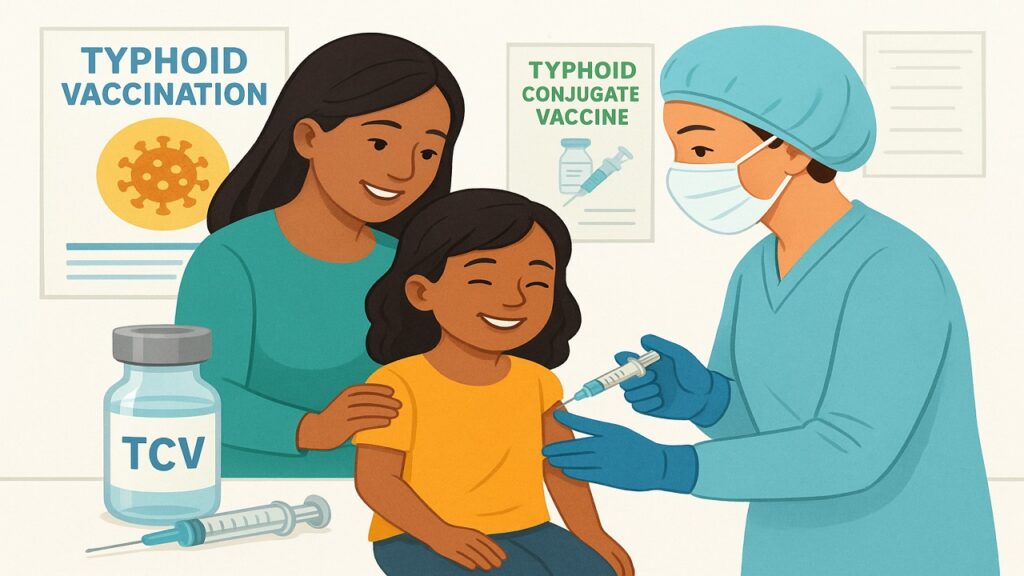Typhoid Conjugate Vaccine: A Preventable Crisis in India

Context
- Recently, Bangladesh became the eighth country globally to introduce the Typhoid Conjugate Vaccine (TCV).
- Target Population: Nearly 50 million children aged 9 months to 15 years will receive the vaccine as part of a campaign.
- Integration: Post-campaign, TCV will be included in the routine immunisation programme.
- Significance for India: India produces this vaccine and carries half the global burden of typhoid, yet it is not yet part of the country’s routine childhood vaccination schedule.
What is Typhoid Conjugate Vaccine (TCV)?
- Definition: TCV is a vaccine that provides immunity against typhoid fever, caused by Salmonella Typhi.
- Dosage: Administered as a single-dose injection, stimulating antibody production.
- Efficacy: Effective in infants and young children, unlike older vaccines with age restrictions.
- Regional Status: Nepal, Pakistan, and Bangladesh have already started vaccination programs.
- India’s Scenario:
- Typbar TCV by Bharat Biotech (manufactured since 2013) was WHO prequalified in 2017.
- India supplies vaccines regionally but has not introduced it in UIP.
Epidemiology of Typhoid
- Causative Agent: Salmonella Typhi.
- Transmission:
- Human-to-human, via faecal or urinary contamination of food and water.
- Vectors like flies can spread it.
- Survives in milk, ice, and food without taste change.
- Asymptomatic carriers can shed bacteria for months to years.
- Symptoms & Effects:
- Fever lasting several weeks
- Severe complications: intestinal perforation, which can be fatal
- Children disproportionately affected, leading to loss of schooling and activity
- Global Burden:
- 9–12 million cases annually
- Over 100,000 deaths, concentrated in India, Bangladesh, Pakistan
- Controlled in countries with better sanitation, diagnostics, surveillance, and travel vaccination
Typhoid in India: Key Data
- Childhood Incidence:
- SEFI study (2017–2020): 10 urban and rural sites
- Incidence: 576–1,173 cases per 100,000 child-years
- Higher in poorer urban areas than rural areas
- Migration Risk: Extensive labor migration spreads the pathogen between urban and rural areas.
- Mortality:
- Estimated 4.5 million cases annually with 8,930 deaths
- India contributes to half the global burden
- Future Projections:
- Without intervention: 46 million cases and 89,300 deaths annually
- Affects all age groups in urban areas and young adults in rural areas
Challenges in Combating Typhoid
- Diagnostic Gaps:
- Symptoms mimic dengue, malaria, COVID-19, scrub typhus
- Blood culture is recommended but limited in availability
- Over-reliance on Widal test, which is unreliable
- Lack of antimicrobial susceptibility testing
- Antibiotic Resistance:
- Resistance rising since 1950s
- Current treatment: azithromycin and ceftriaxone
- Resistance emerging to both drugs (2021–2024)
- XDR strains in Pakistan pose imminent threat
- Rising resistance increases treatment cost and limits options
- Sub-optimal Sanitation:
- Despite Swachh Bharat Mission and Jal Jeevan Mission, water quality remains poor
- Only 6% of urban households have safe water; rural coverage worse
- Environmental surveillance limited and inadequate
Way Forward
- Vaccine Introduction:
- WHO recommended TCV in 2018, especially for children in endemic regions
- Private sector cost: ~₹2,000, limiting access
- Inclusion in UIP is essential for health equity
- Complementary Measures:
- Strengthen environmental and disease surveillance
- Improve WASH (Water, Sanitation, Hygiene) measures
- Enhance diagnostics and resistance mapping
- Regulate prescriptions
- Conduct post-vaccination efficacy studies
- Vaccine Support:
- Cost-effective: Single dose, protection for 3–10 years
- Safe: Co-administered with routine vaccines from 6 months
- Field Trials: Navi Mumbai (2018): 1 lakh doses, cost USD 1.87 per dose
- Produced by Serum Institute of India and Zydus Lifesciences
- Policy & International Support:
- NTAGI repeatedly discussed typhoid vaccination since 2016
- GAVI partnership (2023): $250 million to support TCV in UIP
- Implementation remains delayed
Conclusion
- The delay in India is concerning as neighbors like Bangladesh, Nepal, and Pakistan have acted decisively.
- Typhoid remains a preventable yet deadly disease, disproportionately affecting children and vulnerable populations.
- With proven vaccine technology, cost-effective production, and international backing, India has the tools and opportunity to eliminate typhoid.
- Action is overdue: Integrating TCV into the routine immunisation programme can save countless lives and prevent economic and social losses.
Source : The Hindu
